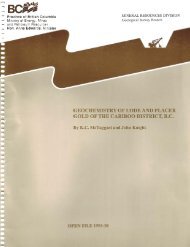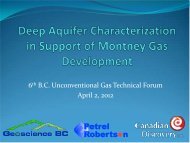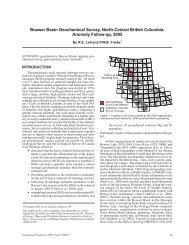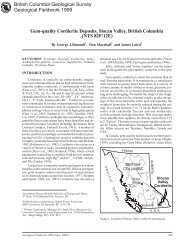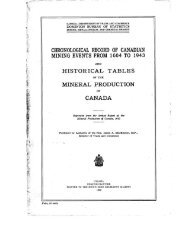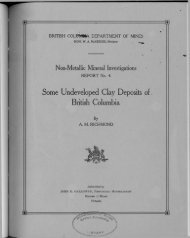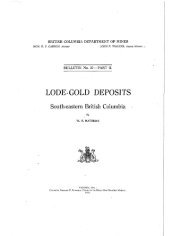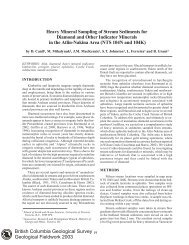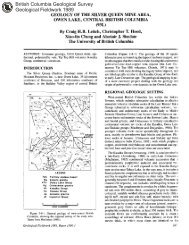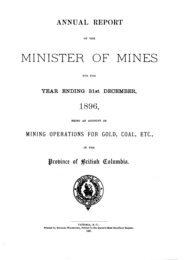A Geological Overview of the Hedley Gold Skarn - Ministry of Energy ...
A Geological Overview of the Hedley Gold Skarn - Ministry of Energy ...
A Geological Overview of the Hedley Gold Skarn - Ministry of Energy ...
You also want an ePaper? Increase the reach of your titles
YUMPU automatically turns print PDFs into web optimized ePapers that Google loves.
A GEOLOGICAL OVERVIEW OF THE HEDLEY GOLD SKz4RN DI!ITRICT<br />
SOUTHERN BRITISH COLUMBIA (92H)<br />
By G.E. Ray, I.C.L. Webster, B.C. <strong>Geological</strong> Survey Br:anch<br />
G.L. Dawson, The University <strong>of</strong> British Columbia<br />
A.D. Ettlinger, Santa Fe Pacific Mining Inc.<br />
KEYWORDS: Economic geology, gold skam, <strong>Hedley</strong>,<br />
Upper Triassic, Nicola, stratigraphy, hack-arc hesin, slump<br />
hreccias, Mount Riordan, garnet skam, industrial minerals.<br />
INTRODUCTION<br />
This paper presents an updated overview <strong>of</strong> <strong>the</strong> geology<br />
and mineral deposits in <strong>the</strong> <strong>Hedley</strong> mining district, south-<br />
central British Columbia. The district contains <strong>the</strong> Nickel<br />
Plate gold skarn deposit, which is currently being operated<br />
by Homestake Canada Ltd. (formerly Corona Corporation),<br />
as well as several past-producing gold skams: <strong>the</strong> French,<br />
Canty and Good Hope mines (Figure 2-5. I). It also includes<br />
<strong>the</strong> Mount Riordan (Crystal Peak) skarn which is being<br />
evaluated as a potential industrial garnet deposit hy Polestar<br />
Exploration Inc.<br />
Early mapping <strong>of</strong> <strong>the</strong> district geology was completed by<br />
Bostock (1930) and Rice (1947, 1960), and more recently<br />
by Ray and Dawson (1987, 1988. 1993, in preparation), and<br />
Monger (1989). Studies on <strong>the</strong> various gold skarns include<br />
early work hy Camsell (1910). Bostock (1930). Warren and<br />
Cummings (1936), Billingsley and Hume (1941). Dolmage<br />
and Brown (1945), and Lee (1951); recent investigations<br />
have been completed by Ray er al.. (19X7, lY88). Webster<br />
(198X), Ettlingrr and Ray (1989). Ettlinger (1990). Dawson<br />
et al.. (1990a. IYYOh), Ettlinger et al.. (1992), and Ray and<br />
Dawson (I993 in preparation). In addition, details on <strong>the</strong><br />
Mount Riordan industrial garnet deposit have been puh-<br />
lished by Math& <strong>of</strong> al., (1991). Grand et al., (1991) and<br />
Ray ef a/., (1992).<br />
REGIONAL GEOLOGY<br />
The <strong>Hedley</strong> mining district lies within <strong>the</strong> allochtonous<br />
Quesnel Terrane <strong>of</strong> <strong>the</strong> Intermontane Belt. It is situated at<br />
<strong>the</strong> eastern edge <strong>of</strong> <strong>the</strong> Upper Triassic Nicola Group, close<br />
to its contact with Paleozoic and Triassic oceanic rocks <strong>of</strong><br />
<strong>the</strong> Apex Mountain Complex (Figure 2-5-I). which is<br />
believed to he a deformed ophiolite (Milford, 1984).<br />
Elsewhere in south-central British Columbia, <strong>the</strong> Nicola<br />
Group unconformably overlies this package (Read and<br />
Okulitch, 1977). hut at <strong>Hedley</strong> <strong>the</strong> contact is ei<strong>the</strong>r faulted<br />
or occupied by <strong>the</strong> mid-Jurassic Cahill Creek pluton.<br />
The Nicola Group consists largely <strong>of</strong> island-arc<br />
supracrustal rocks that wet-e depxited in an elongate and<br />
rifted marginal marine basin associated with an easterly<br />
dipping subduction zone (Prcto. 1979; Mortimer, 1986,<br />
19,7). West <strong>of</strong> <strong>the</strong> <strong>Hedley</strong> district, alon& <strong>the</strong> main axis <strong>of</strong><br />
<strong>the</strong> arc, <strong>the</strong> group reaches 6000 metres in thickness and is<br />
dominated by mafic, subaerial to submarine volcanic ilows<br />
and tuffaceous rocks in which limestones are uncommon<br />
(Preto, 1979). Fa<strong>the</strong>r east at <strong>Hedley</strong>, however, <strong>the</strong> group is<br />
Geologid Firldwnrk /992. Paper 199.1-I<br />
-.-.<br />
thinner (maximum 3000 m), la&r volcanic flows, and i!;<br />
dominated instead by sedimemxv rocks that il elude bedded<br />
tuffs, calcareous and turhiditic ~iltstones and thick, ert~en..<br />
sive limestones.<br />
Immediately following <strong>the</strong> termination <strong>of</strong> <strong>the</strong> Late<br />
Triassic Nicola arc volcanism, a variety <strong>of</strong> in rusions ~r:ng-<br />
ing from dikes and sills to ma-or hatholiths v we emplxed<br />
into <strong>the</strong> Nicola Group. These intermediate to high-iwel<br />
intrusions, which vary from gahhro to gra~odiorite and<br />
alkaline to calcalkaline in composition, reng : from 19.1 to<br />
210 Ma in age, (F’reto ef a/., 1579; Monger. IY8Y; Parrish<br />
and Monger, 1992). Some <strong>of</strong> <strong>the</strong> alkalic in rusions (“.g.,<br />
Copper Mountain stock) are related to poq~hyry copper-<br />
gold deposits. while some <strong>of</strong> thr: calcalkaline plutons (S!.g.,<br />
Brenda stock) are associated with gold-p )or porpt:yr!i<br />
copper-molybdenum orebodies (Carr, 1968: Preto, 1’172;<br />
Soregamli and Whitford, 1976), In <strong>the</strong> Hedh y district, tb:<br />
Bromley batholith, <strong>the</strong> <strong>Hedley</strong> intrusions a Id <strong>the</strong> Mount<br />
Riordan stock (Figure 2-S-l) were all emplaced during Ihi<<br />
Late Triassic to Early Jurassic plutonic episc de.<br />
DISTRICT STRATIGRAPHY<br />
The Nicola Group at <strong>Hedley</strong> in; a westerly tl lickening, Iat,:<br />
Carnian to late Norian calcarcous sedimer tary and arc-<br />
related volctmiclastic sequence that was d, :posited cn 1<br />
tectonically active, west-dipping paleoslope Figures 2-K?<br />
and 2-5-3 ). Sedimentary facies cthanges ant I paleocutreot<br />
indicators suggest that <strong>the</strong> sed.iments in th: group wxx<br />
derived largely from an eastern source, although th:<br />
alkaline and calcalkaline pyroclastic rocks higher in th:<br />
succession may have originated from <strong>the</strong> Ni, :ola arc I:C th-<br />
west. The Nicola Group in <strong>the</strong> <strong>Hedley</strong> area is bcliaed TV<br />
have been laid down across <strong>the</strong> structure1 h nge LO,,,: thit<br />
marked <strong>the</strong> rifted margin <strong>of</strong> <strong>the</strong> westerly deepening,,<br />
shallow-marine Nicola basin.<br />
At <strong>Hedley</strong>, <strong>the</strong> Nicola Group sedimemry succei!,ion<br />
contains a number <strong>of</strong> newly ::ecognired 1 xmations fra<br />
which formal nomenclature is tww proposed I Ray and Daw-<br />
son, 1993, in preparation). The r,uccession :Figure :!-!i-::)<br />
includes an upper. widely developed and hick (at 1~zx;t<br />
1200 m) unit, <strong>the</strong> Whistle Fornwtion; <strong>the</strong> fort lation camisIs<br />
largely <strong>of</strong> alkalic and suhalke~lic I:uffs and tt ffxcous :;l:d,-<br />
mutts, and its base is occupit:d by an exten! ive lime!xunt:-<br />
boulder deposit, <strong>the</strong> Copperfield hreccia, whi :h reaches 200<br />
metres in thickness. The angulx to well-rotuded limertooe<br />
clasts are commonly I metre ilr diameter al bough, rareI:/,<br />
<strong>the</strong>y reach up to IS metres iacross; <strong>the</strong>y crntain shallow<br />
water bivalves, as well as conodonts that an slightly older<br />
(late Carnian to early Norian) <strong>the</strong>n <strong>the</strong> e:.rly to m dd e<br />
Norian faunas in <strong>the</strong> underlyinjl; Chuchuway na and Hcdley<br />
2ci9
formations (M.J. Orchard, personal communication, 1989)<br />
(Figure 2-5-3). One <strong>of</strong> <strong>the</strong> rare chat clast from <strong>the</strong> hreccia<br />
yielded radiolarians <strong>of</strong> Permian age (F. Cordey. personal<br />
communication, 1985).<br />
Limestone makes up 95 per cent <strong>of</strong> <strong>the</strong> clasts but rare<br />
clasts <strong>of</strong> chert, argillite, siltstone, and volcanic and plutonic<br />
rock are present. Many <strong>of</strong> <strong>the</strong> elongate urgillite and siltstone<br />
clasts are deformed which suggests <strong>the</strong>y were unlithified<br />
when <strong>the</strong>y were incorporated into <strong>the</strong> hreccia. Some appear<br />
to have been scoured from <strong>the</strong> immediately underlying<br />
sedimentary units, and many <strong>of</strong> <strong>the</strong>se units show chaotically<br />
I~~*I~I.I~X.I.IIIXIIIII<br />
” x 1 s x :BROMLEY<br />
11.4”~..“““1”~““.“.11<br />
IXII.XXX”II.XXX”“I.XX<br />
XXI.IIIIX”“I~.-“.I,.\<br />
. % ” 1 x x . .<br />
xIILI”x.<br />
BATHOLITHx<br />
x%.x\<br />
x x ”<br />
GOLD SKARN DEPOSITS<br />
disturbed bedding, presumably caused when <strong>the</strong> breccia<br />
ploughed into <strong>the</strong> unconsolidated silty and argillaceous<br />
sediments.<br />
The Copperfield breccia probably represents a chaotic<br />
gravity-slide deposit formed by <strong>the</strong> catastrophic slumping <strong>of</strong><br />
an unstable accumulation <strong>of</strong> shallow-marine reef debris<br />
down <strong>the</strong> submarine paleoslope. This mass ploughed into,<br />
and was deposited on <strong>the</strong> unconsolidated deeper water sedi-<br />
ments <strong>of</strong> <strong>the</strong> Hrdley, Chuchuwayha and Stemwinder forme-<br />
tions (Figure 2-5-4). The hreccia is probably analogous to<br />
<strong>the</strong> modern megabreccias described along <strong>the</strong> Nicaraguan<br />
NtCKEL PLATE<br />
GOOD HOPE<br />
l MOUNT RIORDAN<br />
GARNET DEPOSIT<br />
~ GEOLOGICAL CONTACTS<br />
.-_--<br />
SCALE<br />
. . . . . . . . . . . . . . . . . . . . . . . . .<br />
5 Km<br />
m Verde Creek stock<br />
JURASSIC<br />
Figure 2-S-l. Geology <strong>of</strong> <strong>the</strong> <strong>Hedley</strong> district and location <strong>of</strong> <strong>the</strong> skam deposits<br />
m Skwel Peken fm.<br />
Lookout Ridge and<br />
Cahill Creek plutons<br />
2 m Mount Riordon siock<br />
L m Mount Riordan skarn<br />
8 r;;l Bromlev batholith<br />
LATE TRIASSIC<br />
<strong>Hedley</strong> intrusions<br />
0 Whistle formation<br />
m Chuchuwaya fm. f;<br />
Ez<br />
m Stemwinder Fm. 0<br />
D <strong>Hedley</strong> Formation<br />
m French Mine Fm.<br />
B Oregon Claims Fm.<br />
PALEOZOIC-TRIASSIC<br />
m Apex Mountain Complex<br />
270 British Columbia <strong>Geological</strong> Survey Branch<br />
z<br />
D
Rise in <strong>the</strong> Western Caribbean (Hine ef ul.. 1992). These<br />
megabreccias form thick (up to 120 m) and extensive<br />
(27 km by 16 km) units and are believed to represent<br />
seismically triggered bank-margin collapse features that<br />
took place along <strong>the</strong> edges <strong>of</strong> low-relief carbonate platforms<br />
(Hine ef al., 1992).<br />
The Whistle Formation is underlain hy a succession in<br />
which four sedimentary facies are distinguished from east to<br />
west: <strong>the</strong> thin (up to 200 m), shallow-marine. limestone-<br />
dolninant French Mine Formation in <strong>the</strong> east, <strong>the</strong> thicker.<br />
siltstone-dominant <strong>Hedley</strong> and Chuchuwayha formations in<br />
<strong>the</strong> central pert <strong>of</strong> <strong>the</strong> area, and <strong>the</strong> thick (up to 2200 m).<br />
deeper water and argillite-dominant Stemwinder Formation<br />
in <strong>the</strong> west. Conodotlts from <strong>the</strong> French Mine, <strong>Hedley</strong> and<br />
Chuchuwayha formations indicate <strong>the</strong>y are Late Triassic<br />
(Carnian-Norian) in age (M.J. Orchard, personal communi-<br />
cation, 1989; Figure 2-S-3). The sedimentary facie% were<br />
separated from one ano<strong>the</strong>r, and panly controlled hy north.<br />
erly trending active growth faults (Figures 2-S-2 and 2-S-4):<br />
<strong>the</strong>se fractures, which were probably related to <strong>the</strong> basin-<br />
margin rift structures, were precursors <strong>of</strong> <strong>the</strong> Chuchuwayha,<br />
Bradshaw and Cahill Creek faults.<br />
The Chuchuwnyha, <strong>Hedley</strong> and French Mine formations<br />
are underlain by a poorly understood sequence <strong>of</strong> mafic<br />
tuffs with tninor flows, limestone and <strong>the</strong>n-pebble con-<br />
glomerate, <strong>the</strong> Oregon Claims Formation (Figure 2-S-2;<br />
Ray and Dawso”, 1093. in preparation). The age <strong>of</strong> this unit<br />
and its contact relationship with <strong>the</strong> overlying Nicola rocks<br />
are uncertain. It may represent <strong>the</strong> oldest exposed section <strong>of</strong><br />
<strong>the</strong> Nicola Group, hut it is more likely to he an older<br />
basement on which <strong>the</strong> Nicola Group was unconformably<br />
deposited, and could be a western extension <strong>of</strong> <strong>the</strong> Apex<br />
Mountain Complex.<br />
A newly recognized mid-Jurassic unit, <strong>the</strong> Skwel Peken<br />
Formation. overlies <strong>the</strong> Nicola Group at <strong>Hedley</strong> (Figure<br />
2-S-l). It has two members. The lower member, 1500<br />
metres thick, is dominated by calcalkaline andesitic to daci-<br />
tic lapilli and ash tuffs that commonly contain glassy,<br />
strongly emhayed and fractured quartr crystuls. Minor<br />
“mounts <strong>of</strong> epiclastic sediments, welded luffs and pyroclas-<br />
tic surge deposits are als” present. The thinner (maximum<br />
400 m) upper member is dominated by massive and&tic<br />
crystal tuffs.<br />
We believe that <strong>the</strong> Skwel Peken Fortnation is <strong>the</strong> first<br />
mid-Jurassic supracrustal unit recognized in south-central<br />
British Columbia. The formation was laid down in a “on-<br />
marine, subaerial to shallow-water enviromnent and is<br />
believed (Ray and Dawson, 1993, in preparation) to repro-<br />
sent extrusive volcimism related to <strong>the</strong> mid-Jurassic Cahill<br />
Creek and Lookout Ridge plutons (Figure 2-5. I). Zircons<br />
extracted from quartz-rich tuffs in <strong>the</strong> lower member give a<br />
tnaximum U-Ph age <strong>of</strong> 18729 Ma (J.E. Gahites, personal<br />
communication, 1992). Minor amounts <strong>of</strong> Cretaceous<br />
Spences Bridge Group and Eocene Springbrook and Mar””<br />
formations are also exposed in <strong>the</strong> area (Figure 2-5-l).<br />
Several episodes <strong>of</strong> plutonism are recognized. The oldest<br />
resulted in <strong>the</strong> quartz dioritic and gahhroic <strong>Hedley</strong> intru-<br />
sions that are associated with widespread gold skarn miner-<br />
alization, including <strong>the</strong> Nickel Plate. Canty, French and<br />
Good Hope deposits. Field evidence and equivocal radi-<br />
ometric U-Pb dating suggest <strong>the</strong>y were intrude 1 during L”te<br />
Triassic to Early Jurassic times. between 21 > to 194 Ma<br />
(J.E. Gahitrs, personal communiation, 199: ). The inwu-<br />
sions occur as large and small r,tocks, us sill dike SIV,II’~S<br />
and as isolated minor bodies; <strong>the</strong> swarms are xeferentially<br />
developed in <strong>the</strong> thinly bedded Chuchuwayh I and Hr:dleq<br />
Figure 2-S-2. Schematic t:a+west wctio across tkr:<br />
<strong>Hedley</strong> district showing sediment;~y fxies cl ages in tt,e<br />
Nicola Group and stratigraphic lw~~ion rf <strong>the</strong> sk,rtn<br />
ieposits.<br />
Figure<br />
-.-_~<br />
2-S-3. Age range af fconadont mic “fossils cotlectrd<br />
fronl <strong>the</strong> Nicola Gnrup, I<strong>Hedley</strong> district Number:; I,<br />
circles refer to fossil sample “urnbers listed in Ray ;ard<br />
Dawsan (1993, in preparation). (Fossils i lrntified t,:i<br />
M.J.Orchard. Geolngical Sur\e:e <strong>of</strong> Canada).<br />
Geo/ogica/ Fieldwork 1992, Pnper IYY3.I 2:71<br />
,
formations. Some elongate bodies, such as <strong>the</strong> Toronto<br />
stock, were intruded along easterly trending lineaments that<br />
mty have been late Triassic transform faults related to <strong>the</strong><br />
rifted basin margin.<br />
A slightly younger plutonic episode resulted in <strong>the</strong> large,<br />
granodioritic Bromley batholith and a related marginal<br />
body, <strong>the</strong> grenodioritic to gabbroic Mount Riordan stock.<br />
The latter is genetically associated with <strong>the</strong> large, garnet-<br />
rich Mount Riordan (Crystal Peak) skarn that contains<br />
minor tungsten-copper occurrences. A radiometric U-Pb<br />
zircon age <strong>of</strong> 194.625 Ma (Early Jurassic) is indicated for<br />
<strong>the</strong> Mount Riordan stock (J.E. &bites, personal communi-<br />
cation, 1992). and a similar age <strong>of</strong> 1931 I is obtained from<br />
<strong>the</strong> Bromley batholith (Parrish and Monger, 1992).<br />
A subsequent phase <strong>of</strong> granodioritic to quartz monzonitic<br />
magmatism is represented by <strong>the</strong> Lookout Ridge and Cahill<br />
Creek plutons. The latter, which commonly separates <strong>the</strong><br />
Nicola Group to <strong>the</strong> west from <strong>the</strong> Apex Mountain Complex<br />
fur<strong>the</strong>r east, yields a U-Pb zircon mid-Jurassic date <strong>of</strong><br />
168.859 Ma (J.E. Gabites, personal communication, 1992).<br />
These high-level plutons are spatially related to a suite <strong>of</strong><br />
minor aplites and quartz porphyry intrusions that yield a<br />
Late Jurassic U-Pb zircon date <strong>of</strong> 154.5 +8 -43 Ma. The<br />
plutons are believed to be <strong>the</strong> magmatic source <strong>of</strong> <strong>the</strong><br />
I Ch”sh”rayha %dl.Y Frmch<br />
Formafion Formafion Fotm.fion<br />
2<br />
sea ”<br />
“““““yyI,...““““““““’<br />
“Y”“““““““~<br />
““YYYY”““”<br />
,“Y”“““YYY”“’<br />
*Y”“Y”““““Y”<br />
YY”““““““““”<br />
I<br />
volcaniclastic package in <strong>the</strong> nearby Skwel Peken Forma-<br />
tion (Ray and Dawson. 1993, in preparation).<br />
The youngest major intrusion in <strong>the</strong> district is <strong>the</strong> gra-<br />
nitoid Verde Creek stock (Dolmage, 1934) which is coeval<br />
with <strong>the</strong> Early Cretaceous Spences Bridge Group (Preto,<br />
1972); it intrudes <strong>the</strong> Nicola Group in <strong>the</strong> western part <strong>of</strong> <strong>the</strong><br />
district (Figure 2-5-l).<br />
A rare, distinctive suite <strong>of</strong> leucocratic, calcalkaline minor<br />
intrusions (or possible volcanic flows) is spatially associ-<br />
ated with <strong>the</strong> Skwel Peken Formation. These rocks contain<br />
magmatic garnet phenocrysts with almandine-rich cores and<br />
spesswtine-rich margins that are chemically and optically<br />
distinct from <strong>the</strong> grossular-andradite garnets in <strong>the</strong> gold<br />
skams.<br />
STRUCTURAL GEOLOGY<br />
Two deformational episodes are identified in both <strong>the</strong><br />
Apex Mountain Complex and Nicola Group, although <strong>the</strong><br />
temporal relationship <strong>of</strong> <strong>the</strong> episodes between one rock<br />
package and <strong>the</strong> o<strong>the</strong>r is unknown. The first and most<br />
intense episode identified in <strong>the</strong> Apex Mountain Complex<br />
resulted in tight to isoclinal minor folds with moderate to<br />
strong, nor<strong>the</strong>rly to nor<strong>the</strong>ast-striking and subvertically<br />
Figure 2-5-4. Depositional history <strong>of</strong> <strong>the</strong> Nicola Group in<br />
<strong>the</strong> <strong>Hedley</strong> area:<br />
I Camian-Norian deposition <strong>of</strong> <strong>the</strong> French, Hrdley,<br />
Chuchuweyha and Stemwinder formations onto <strong>the</strong><br />
Oregon Claims Formation adjacent to <strong>the</strong> rifted east-<br />
ern margin <strong>of</strong> <strong>the</strong> Nicola basin. Sedimentation was<br />
from an eastern source and <strong>the</strong> facies were controlled<br />
by active, normal growth faults that were precursor<br />
structures for <strong>the</strong> Chuchuwayha, Bradshaw and Cahill<br />
Creek faults.<br />
2. Late Triassic - catastrophic deposition <strong>of</strong> <strong>the</strong> Copper-<br />
field breccia into <strong>the</strong> basin as a chaotic mass-gravity<br />
slide from shallow-marine facies to <strong>the</strong> east. This was<br />
possibly triggered by earth movements associated with<br />
development <strong>of</strong> <strong>the</strong> main Nicola arc far<strong>the</strong>r west.<br />
3. Late Triassic major air?& <strong>of</strong> Whistle Formation ash<br />
and lapilli luffs from an unknown source. Sedimentary<br />
curren6 wcrc still from <strong>the</strong> east but coadirions did not<br />
allow limestone deposition.
inclined penetrative axial planar fabrics; no major folds <strong>of</strong><br />
this age are recognized The second period <strong>of</strong> deformation is<br />
only locally developed in <strong>the</strong> Apex Mountain rocks. It<br />
resulted in nor<strong>the</strong>rly striking, subvertical open folds, but is<br />
not associated with any penetrative fabrics.<br />
Both <strong>of</strong> <strong>the</strong> deformations1 episodes identified in <strong>the</strong> Nic-<br />
01s Group predate <strong>the</strong> Skwel Peken Formation and <strong>the</strong><br />
Cahill Creek pluton which suggests <strong>the</strong>y are pre-Middle<br />
Jurassic in age. The first episode, which was only locally<br />
developed in <strong>the</strong> Nicola Group, produced west to northwest-<br />
Host formation and age<br />
Hostrock<br />
lithology<br />
Associated Intrusive rocks<br />
Age <strong>of</strong> intrusions<br />
Initial 6’SrpSr<br />
<strong>of</strong> intrusions<br />
Skam mineralogy<br />
Opaque minerals<br />
Degree <strong>of</strong> skarn<br />
alteration<br />
Approximate exposed<br />
area <strong>of</strong> skarn<br />
Nickel Plate Mt. Riordan<br />
striking minor flexures that were probably re ated to <strong>the</strong><br />
forcible emplacement <strong>of</strong> <strong>the</strong> Hr:dley intrusion: At Nickel<br />
Plate, <strong>the</strong>se structures partly controlled <strong>the</strong> golf I skarn mirl-<br />
eralization (Billingsley and Hurne, 1941).<br />
The second deformation in ;hc Nicola Gn ‘up was <strong>the</strong><br />
dominant structural event in <strong>the</strong> district. It KS, lted in ra;t-<br />
erly overturned minor and major asymmetric folds w 1.h<br />
nor<strong>the</strong>rly striking, steep westerly dipping axi planes. It<br />
produced s large anticlinal strucI:ure with its ax] 3 just es:,t <strong>of</strong><br />
<strong>the</strong> Nickel Plate deposit. L~ally, argillites i I <strong>the</strong> Stw-<br />
-- -- .<br />
-.- --.-<br />
Upper Triassic <strong>Hedley</strong> Fm. ?Upper Triass,ic French Mint Fm?<br />
-- __-.-<br />
Predominantly siltstone. ?Massive limsstone and<br />
minor limestone carbonate breccla?<br />
-- --.-<br />
<strong>Hedley</strong> intrusions (gabbro. diorite) Mount Riordan Estock (grano iioritegabbro)<br />
-.- --.-<br />
Post 219and pre 194 Ma 194.6+5 Ma (E,?riyJurassic)<br />
(Late Triassic - Early Jurassic)<br />
-- --.-<br />
0.7036’ 0.7044*<br />
-- --.-<br />
Banded, clinopyroxene- Massive. garnetxlominant sl am.<br />
dominant skam with sulphides and scapoliie. Coarse, euhedral garnets wi :h<br />
Garnets generally anhedral and brown coloured. highly variable colour. Gem ‘rally )<br />
No scheelite present. low sutphide content. Minor pyroxene, ;<br />
actinolite. epidote. Scheelitm! present.<br />
-.- --.-<br />
Pyrrhotite, arsenopyrite, Magnetite, pyrrhotite, pyrite<br />
minor chalcopyrite and rare pyrite minor chalcopyrite.<br />
-.- --.-<br />
Original sedimentary bedding Vimally no prknary strwtw ?S<br />
commonly preserved In skam. preserved.<br />
4 km2 0.3 km2<br />
Maximum thickness <strong>of</strong> skarn 300 m At least 175 m<br />
-.- --.-<br />
Geochemistry <strong>of</strong> Anomalous Au,As,Cu,Co.Bi,Te,Ag.Sb Anomalous Cu,W.Ag,Mo<br />
mineralization<br />
Garnet composition Low Mn (< 0.5% MnO)<br />
Grossutarltic cores, andraditic margins<br />
Ad 15-60<br />
Pyroxene composition Low Mn (< 1.0% MnO)<br />
Hd 40-95<br />
R.L Armstrong, personal communication 1969.<br />
Low Mn (< 1.6 % MnO<br />
Andraditic cores, grossulari ic margin ;<br />
Ad 45..96<br />
Low Mn (< 1,3 % MnO)<br />
Hd 41-51<br />
Ceolo@zl Fiddwork 1992, Pqer 1993-1 27.1<br />
--.-<br />
I
winder and Chuchuwayha formations contain a fracture<br />
cleavage related to this deformation, although elsewhere<br />
axial planar penetrative fabrics are absent.<br />
In addition to <strong>the</strong> above two episodes, a younger period<br />
<strong>of</strong> folding has gently deformed <strong>the</strong> Skwel Peken Formation.<br />
This post-mid-Jurassic deformation resulted in open minor<br />
flexure folds with nor<strong>the</strong>asterly striking axial planes.<br />
ECONOMIC GEOLOGY<br />
The <strong>Hedley</strong> district has important skarn deposits (Figures<br />
2-S I and 2-5-2) as well as some minor gold-bearing quartz-<br />
carbonate veins. The skarns are separable into two types:<br />
older and more economically imponant gold skams such as<br />
<strong>the</strong> Nickel Plate, Canty, French and Good Hope deposits<br />
PRODUCTION FROM VEINS - HEDLEY DlSTRlCT<br />
that generally have low gametlpyroxene ratios, and younger<br />
skarns that have high gametlpyroxene ratios, and contain<br />
minor tungsten and copper but little or no gold. The Mount<br />
Riordan (Crystal Peak) skam is <strong>the</strong> largest <strong>of</strong> this second<br />
type: it is a potential industrial garnet deposit with drill-<br />
indicated resewes <strong>of</strong> 40 million tonnes averaging<br />
78 per cent by volume garnet (Mathieu ef al., 199 I; Grand<br />
et al., 199 I). Differences between <strong>the</strong> gold skams, repre-<br />
sented by <strong>the</strong> Nickel Plate deposit, and <strong>the</strong> garnet-dominant<br />
Mount Riordan skam are listed in Table 2-S I.<br />
<strong>Gold</strong> skarns have produced over 62 tonnes <strong>of</strong> gold from<br />
8.4 million tonnes <strong>of</strong> ore (Table 2-S-2); over 97 per cent <strong>of</strong><br />
<strong>the</strong> gold was derived from <strong>the</strong> Nickel Plate deposit. By<br />
contrast, <strong>the</strong> quartz-carbonate veins, such as <strong>the</strong> Pine Knot,<br />
Maple Leaf and <strong>Gold</strong> Zone veins, have produced only 33<br />
kilograms <strong>of</strong> gold (Table 2-5-3). The gold grade <strong>of</strong> <strong>the</strong><br />
Nickel Plate ore, worked during <strong>the</strong> early underground<br />
operations, ranged from 12 to 14 grams per tonne gold,<br />
whereas <strong>the</strong> ore currently mined by open-pit methods ranges<br />
between 2 and 3.1 grams per tonne gold (Table 2-5-2). The<br />
overall grade <strong>of</strong> all <strong>the</strong> gold skam deposits mined in <strong>the</strong><br />
district is 7.43 grams per tonne gold.<br />
The gold skams we genetically and spatially related to<br />
diorite-gabbro stocks and dike-sill swarms <strong>of</strong> <strong>the</strong> <strong>Hedley</strong><br />
intrusions. Economic gold skarns are hosted only in <strong>the</strong><br />
Nicola Group, and on both a district and mine scale are<br />
structurally, stratigraphically and lithologically controlled.<br />
They favour areas where <strong>the</strong> <strong>Hedley</strong> intrusions cut <strong>the</strong><br />
calcareous, shallower marine sedimentary facies <strong>of</strong> <strong>the</strong><br />
<strong>Hedley</strong> and French Mine formations (particularly rocks that<br />
are flat lying or gently dipping) but are absent in <strong>the</strong> deeper<br />
water sediments <strong>of</strong> <strong>the</strong> Stemwinder Formation far<strong>the</strong>r west<br />
(Figure 2-5-2).<br />
Economic gold mineralization is almost wholly confined<br />
to <strong>the</strong> exoskam. although locally <strong>the</strong> endoskarn is cut by<br />
late, thin veinlets <strong>of</strong> auriferous sulphides. Exoskam altera-<br />
tion varies from narrow .?ones less than 10 m&es wide to<br />
large envelopes hundreds <strong>of</strong> metres thick. The largest<br />
exoskarn envelope is at Nickel Plate where it outcrops over<br />
4 square kilometres (Figure 2-5.5), is up to 300 metres<br />
thick, and is estimated to contain between 0.75 and 1.5<br />
cubic kilometres <strong>of</strong> altered rock. Alteration is characterized<br />
by pyroxene-garnet-carbonate-scapolite assemblages, and<br />
mineralogical zoning is present in both <strong>the</strong> mineralized and<br />
barren skams. This zoning generally consists <strong>of</strong> coarser<br />
grained garnet-rich proximal assemblages and finer grained<br />
pyroxene-rich distal assemblages (Figure 2-5-5). <strong>Gold</strong>-<br />
pyrrhotite-arsenopyrite mineralization is preferentially<br />
developed in <strong>the</strong> distal, pyroxene-dominant skam, and is<br />
associated with a gecchemical enrichment in arsenic, cop-<br />
per, bismuth, tellurium, cobalt, zinc, antimony, molyb-<br />
denum, and nickel.<br />
Significant geochemical and mineralogical variations are<br />
seen throughout <strong>the</strong> gold skams. At Nickel Plate, chal-<br />
copyrite and CulAu ratios increase westwards towards <strong>the</strong><br />
<strong>Hedley</strong> intrusion Toronto stock, and AulAg ratios are<br />
greater than I in <strong>the</strong> nor<strong>the</strong>rn part <strong>of</strong> <strong>the</strong> deposit and less<br />
than 1 in <strong>the</strong> south.<br />
Bismuth tellurides (hedleyite, tetradymite), arsenopyrite<br />
and high pyrrhotitelpyrite ratios characterize <strong>the</strong> gold ore:<br />
274 Rriti.yh Columbia <strong>Geological</strong> Survey Branch
al\o present throughout <strong>the</strong> ore are chalcopyrite and trace<br />
\phalerite toge<strong>the</strong>r with traces <strong>of</strong> bismuth, nickel and cobalt<br />
minerals (native bismuth, maldonite, breithauptite,<br />
gersdorffitr and cobaltite). Native gold, intimately associ-<br />
ated with tellurides, occurs as minute blebs (maximum 25<br />
microns across) in arsenopyrite and less commonly in pyr-<br />
rhotite (Warren and Cummings, 1936). The gold-sulphide<br />
mineralization is generally coeval with widespread scapoli-<br />
tization (Billingsley and Hume, 1941; Dolmage and Brown,<br />
1945; Ettlinger era/., 1992). The close temporal and spatial<br />
association between gold and scapolite suggests that<br />
chlorine-rich fluids may have been important in <strong>the</strong> trans-<br />
portation and precipitation <strong>of</strong> gold in <strong>the</strong> <strong>Hedley</strong> skams.<br />
The proposed model for <strong>the</strong> Nickel Plate deposit (Figure<br />
2-5-6) involves metals being derived from <strong>the</strong> <strong>Hedley</strong> intru-<br />
sions and transported by large volumes <strong>of</strong> reduced magma-<br />
tic fluid into a strongly reduced calcareous sedimentaty<br />
sequence. Formation <strong>of</strong> <strong>the</strong> large exoskarn envelope was<br />
accompanied by an early, high-temperature mineral<br />
sequence <strong>of</strong> (I) biotite and orthoclase, followed in turn by<br />
(2) manganese-poor, generally hedenbergitic clinopyroxene<br />
(Hdx,~,,), and (3) grandite garnet (Ad,,~ ,,,,, ). The overall<br />
compositional zoning in <strong>the</strong> larger Nickel Plate garnets is<br />
from grossuleritic cores to andraditic margins, and both <strong>the</strong>y<br />
and <strong>the</strong> pyroxene tend to have a low manganese content (
It is postulated that a large <strong>the</strong>rmal cell formed around <strong>the</strong><br />
Nickel Plate skarn (Figure 2-5-6). This probably resulted in<br />
<strong>the</strong> influx <strong>of</strong> cooler, more oxygen-rich meteoric waters into<br />
<strong>the</strong> bottom <strong>of</strong> <strong>the</strong> system which mixed with <strong>the</strong> magmatic<br />
fluids and resulted in <strong>the</strong> deposition <strong>of</strong> sulphides and gold.<br />
Consequently, ore horizons are preferentially developed<br />
near <strong>the</strong> base and lateral margins <strong>of</strong> <strong>the</strong> alteration envelope,<br />
close to its contact with underlying limestones. By contrast,<br />
<strong>the</strong> upper and middle portions <strong>of</strong> <strong>the</strong> skarn tend to be barren<br />
(Figure 2-5-6). This zoning has relevance regarding future<br />
exploration <strong>of</strong> o<strong>the</strong>r, apparently barren, skarn outcrops that<br />
may mask mineralization at depth.<br />
Figure 2-5-6. Schematic diagram showing postulated<br />
development <strong>of</strong> <strong>the</strong> Nickel Plate skarn envelope:<br />
A: intrusion <strong>of</strong> <strong>the</strong> Toronto stock and associated sill-dike<br />
complex.<br />
B: Infiltration <strong>of</strong> hydro<strong>the</strong>rmal fluids to produce a 100.<br />
m&e-thick, pyroxcne-rich prograde skam envelope with<br />
upper fine-grained siliceous zone. Coarser grained and<br />
garnet-dominant skarn developed adjacent to intrusions.<br />
C and D: The formation <strong>of</strong> a large <strong>the</strong>rmal cell around<br />
<strong>the</strong> skarn leads to an influx <strong>of</strong> meteoric water into <strong>the</strong> base<br />
<strong>of</strong> <strong>the</strong> system causing precipitation <strong>of</strong> <strong>the</strong> sulphide-gold-<br />
scapolite orebodies. Some quartz-carbonate veins develop<br />
along fractures above <strong>the</strong> envelope.<br />
<strong>Geological</strong> Fieldwork 1992, Pupper I YY3-1<br />
i\ district-wide, east-to-west ‘:: hange in tht metallo;;cny.<br />
mineralogy and oxidation stat? (<strong>of</strong> <strong>the</strong> skam is suggcited.<br />
Pyroxene-dominant and strongly n:duced ska ‘ns containin;;<br />
gold, arsenopyrite and bismuth tellurides occ lr in <strong>the</strong> west<br />
and central parts <strong>of</strong> <strong>the</strong> distxt. while n ore oxidin%l<br />
tungsten-bearing and garnet-do,minent skarr such as <strong>the</strong><br />
Mount Riordan skam occur in rhc east (Ray ef [I/.. 1992).<br />
This zoning is partly due to <strong>the</strong> different xc imentnry :ro-<br />
toliths <strong>of</strong> <strong>the</strong> various skams whit h reflect <strong>the</strong> original wdi-<br />
mentary facies changes in <strong>the</strong> Nicola Gro tp across <strong>the</strong><br />
district. It is also related to tb: different age and composi~<br />
tions <strong>of</strong> <strong>the</strong> associated intrusions responsible for <strong>the</strong> gold<br />
skarns and <strong>the</strong> Mount Riordan garnet skam.<br />
CONCLUSIONS<br />
The <strong>Hedley</strong> district straddle< <strong>the</strong> eastern te ,tonic edge <strong>of</strong><br />
<strong>the</strong> Late Triassic Nicola back-,an: basin, ani its geolog:/<br />
provides an insight into how rifting contra led <strong>the</strong> basin<br />
margin, <strong>the</strong> easterly derived wdiment;ltion, and drvel’sp-<br />
merit <strong>of</strong> several economically important sedin lrntary fwes.<br />
Dramatic evidence <strong>of</strong> syntectonic sedimenxtion is dis-<br />
played in one distinct marker horizon, <strong>the</strong> Col perfield brec-<br />
cia, which represents a chaotic grwity-slide ( eposit <strong>of</strong>f carp<br />
bonate reefal debris. The breccia was pnrbabl: derived fax<br />
a shallow-marine, carbonate platform that xiginall:y Ia:/<br />
immediately east <strong>of</strong> Hedlry. Similar gravity- slide brec:iar<br />
could be expected to mark pwximity to <strong>the</strong> eastern bwnd-<br />
ary <strong>of</strong> <strong>the</strong> Nicola basin elsewher: in British ( olumbia. l‘hc<br />
Copperfield breccia probably has a similar origin as <strong>the</strong><br />
extensive modern megabrecci;l Iunits that OCI urr along <strong>the</strong><br />
margins <strong>of</strong> low-relief carbonate platforms i I <strong>the</strong> wcstm<br />
Caribbean (Hine CI al.. 1992).<br />
In addition to several minor gold-bearing eins, <strong>the</strong> dis-<br />
trict contains some major gold skarn deposits as well as <strong>the</strong><br />
Mount Riordan garnet skarn wbic:h has indt strial mineral<br />
potential. The latter is associaed with <strong>the</strong> I)4 Ma (iE+<br />
Jurassic) Mount Riordan stock whereas <strong>the</strong> g )Id skarre arc<br />
genetically related to <strong>the</strong> slightly older Hed::y intru!;i,>ns.<br />
The <strong>Hedley</strong> intrusions, in comparison with .xher igwou:;<br />
rocks related to iron, copper. zinc-lead, tun ;sten, rnn :yb-<br />
denum and tin skams, are <strong>the</strong> last differenti !trd and taw:<br />
<strong>the</strong> highest content <strong>of</strong> iron, magnesium. alu nina and :ill-<br />
cium. This chemistry reflects <strong>the</strong>ir derivation 1 mm primitive<br />
oceanic crust in an island arc environment.<br />
In contrast to <strong>the</strong> rarer oxidize d gold skarr s, such as thr:<br />
McCoy deposit in Nevada (Kuyper, 1987; E rookes ef o/.<br />
1990). and <strong>the</strong> McLymont property in nor<strong>the</strong>rn British<br />
Columbia (Ray ef al., 19911, <strong>the</strong> Nickel I’late. French.<br />
Canty and Good Hope depositi; represent clas ;ical redoed-<br />
type gold skam systems. Their reduced sti te is drrron-<br />
strated by high pyrrhotite/pyrii:e and low Fe, &/Fe0 ratio:;<br />
in <strong>the</strong> ore, and <strong>the</strong> presence <strong>of</strong> native bistruth, iron-.icb<br />
biotite and hedenbergitic pymx.ene. Progres+e skarn o er-<br />
printing <strong>of</strong> <strong>the</strong> intrusions and calcareous silt% ones at Nickel<br />
Plate is accompanied by a shaql decrease in th: iron cont~zn:<br />
<strong>of</strong> <strong>the</strong> endoskarn and a corrrsp~mding increasr in iron in <strong>the</strong>:<br />
adjacent exoskam. It is belieed that <strong>the</strong> rmgmatic fer,.<br />
romagnesian minerals in <strong>the</strong> Hed,ley intrusion ;, which were<br />
broken down during skarn alteration, were th : main swrcc<br />
<strong>of</strong> <strong>the</strong> iron enrichment in <strong>the</strong> exoskam.<br />
:277
The <strong>Hedley</strong> district still has good exploration potential<br />
for gold-skam discoveries, particularly as <strong>the</strong> Nickel Plate<br />
model suggests that some <strong>of</strong> <strong>the</strong> larger, untested and appar-<br />
ently barren skarn envelopes in <strong>the</strong> district may overlie<br />
mineraliration at depth. While underground mining would<br />
not be economically feasible on <strong>the</strong> Nickel Plate ore cur-<br />
rently being worked by open-pit methods, it should be<br />
remembered that <strong>the</strong> ore extracted between 1904 and 1963<br />
by underground mining graded I2 to 14 grams per tonne<br />
gold.<br />
The deposit model and ore controls postulated at <strong>Hedley</strong><br />
are applicable to o<strong>the</strong>r areas <strong>of</strong> <strong>the</strong> Cordillera. Tectonic<br />
hinge zones marking rifted margins <strong>of</strong> island-arc or margi-<br />
nal basins are considered to be highly favourable for gold<br />
skams. Such areas containing abrupt facies changes with<br />
reduced calcareous sediments and porphyritic ilmenite-<br />
hearing dioritic to gabbroic intrusions are ideal for gold<br />
skarn development. In particular. exploration should be<br />
directed to intrusions that are iron-rich (greater than 7%<br />
total iron), have low FqO,iFeO ratios and are associated<br />
with pyroxene-dominant exoskarn systems containing early<br />
orthoclase-biotite alteration, high pyrrhotite/pyrite ratios,<br />
arsenopyrite, bismuth tellurides and scapolite.<br />
ACKNOWLEDGMENTS<br />
Part <strong>of</strong> <strong>the</strong> mapping and study costs were financed by <strong>the</strong><br />
Canada - British Columbia Mineral Development Agree-<br />
ment 1985-1990. We wish to thank <strong>the</strong> management, staff<br />
and former staff <strong>of</strong> <strong>the</strong> following companies and organira-<br />
tions for <strong>the</strong>ir considerable assistance and co-operation:<br />
Homestake Canada Ltd. (formerly Corona Corporation and<br />
Mascot <strong>Gold</strong> Mines Ltd.). particularly I. Bellemy, A.H.<br />
Ransom, R. Simpson, W. Wilkinson, H.G. Ewanchuk and<br />
L.W. Saleken; Polestar Exploration Inc., particularly H.C.<br />
Grand and R. Wolfe; Banbury <strong>Gold</strong> Mines Ltd., particularly<br />
M.R. Sanford: Chevron Canada Resources Limited, par-<br />
ticularly E. D. Dodson and L.A. Dick; and <strong>the</strong> Similkameen<br />
Indian Band, particularly Chief B. Allison and G. Douglas.<br />
M.J. Orchard and F. Cordey <strong>of</strong> <strong>the</strong> <strong>Geological</strong> Survey <strong>of</strong><br />
Canada, identified <strong>the</strong> micr<strong>of</strong>ossils. The zircon U-Pb ana-<br />
lyses were completed at <strong>the</strong> Department <strong>of</strong> Geology, The<br />
University <strong>of</strong> British Columbia, by J.E. Gabites, D. Murphy<br />
and P. Van der Hayden. Assistance in <strong>the</strong> field was given by<br />
M.E. MacLean, M. Mills and M. Fournier. Informative<br />
discussions with J.W.H. Monger, L.A. Dick, J. Hammack<br />
and <strong>the</strong> late R.L. Armstrong are appreciated. The figures<br />
were drafted by I.C.L. Webster, A.R. Pettipas and M.S.<br />
Taylor, and <strong>the</strong> paper was considerably improved by <strong>the</strong><br />
editing <strong>of</strong> J.M. Newell.<br />
REFERENCES<br />
Billingsley, P. and Hume. C.G. (1941): The Ore Deposits <strong>of</strong> Nickel<br />
Plate Mountain. <strong>Hedley</strong>. B.C.; Canadian Insrirarc <strong>of</strong> Mining<br />
and Metullurg?: Bulletin, V&me. 44, pages 524-590.<br />
Bostock, H.S. (1930): Geology and Ore Deposits <strong>of</strong> Nickel Plate<br />
Mountain. <strong>Hedley</strong>, B.C.; in Summary Report 192’). Part A,<br />
Gdo,qknl Surve? <strong>of</strong> Cr,,,ad
Math& G.I.. Boisclair, M.R. and Wolfe., R.. (1991): Geology,<br />
Miner&a and Proccssine <strong>of</strong> Mount Rio&n Garnet Ores; irr<br />
Industrial Minerals 111 Alberta and British Columbia, Canada.<br />
Proceedings 27th Forum on <strong>the</strong> Geology <strong>of</strong> Industrial Min-<br />
erals, Banff. Albert;,. “ora, Z.D.. Hamilton, W.N.. Grant, B.<br />
and Kelly, P.D.. Editors, R.C. Minion,: @&erjiy, Mines n,td<br />
Pmvleum Resowc~s. “pen File ,YYl-23, pages I35- 14.5.<br />
Meinert, L.D. (1983): Variability <strong>of</strong> Skam Deposits: Guides to<br />
Exploration; in Revolution in <strong>the</strong> Earth Sciences Advances<br />
in <strong>the</strong> Past Half-Century. Boardman. S.J., Editor. Kmdal/<br />
/fun1 Puhlirhinfi C,wn,x,n~, pagrs 301-3 16.<br />
Milford, J.C. (1984): Geology <strong>of</strong> <strong>the</strong> Apex Mountain Group, North<br />
and East <strong>of</strong> <strong>the</strong> Similkameen River. South-central British<br />
Columbia; unpublished M.Sc. <strong>the</strong>sis, The University <strong>of</strong>Briri.sh<br />
Cdumhin.<br />
Monger. J.W.H. (19893: Geology <strong>of</strong> Hope and Ashcr<strong>of</strong>t Map<br />
Areas, British Columbia: <strong>Geological</strong> Sw’ve~ <strong>of</strong> Cunodo. Map<br />
42-1989.<br />
Monimer, N. (1986): L;lte Triassic. Arc-related. Potassic Igneous<br />
Rocks in <strong>the</strong> Nonh American Cordillem: Guo/op?: %rlume<br />
14. pages 1035.lO:)8.<br />
Mortimer, N. (1987): The Nicola Group: Late Triassic and Early<br />
Jurassic Subduction-related Volcanism in British Columbia;<br />
Canadian Joumul <strong>of</strong> Eurrh Sciencu, Volume 24. pages<br />
2521-2536.<br />
Parrish, R.R. and Monger, J.W.H. (1992): New U-Ph Dates from<br />
Southwestern British Columbia; in Radiogenic Age and Iso-<br />
tope Studies: Report .5: tieolo@cnl Sundry <strong>of</strong> Cmada. Paper<br />
91-2, pages R7-108.<br />
Preto, V.A.. Osatenko, M.J., McMillen, W.J. and Armstrong, R.L.<br />
(197’1): Isotopic Dates and Strontium Isotopic Ratios for Plu-<br />
tonic and Volcanic Rocks in <strong>the</strong> Quesnel Trough and Nicola<br />
Bell, South-central British Columbia; Cmadion Journal <strong>of</strong><br />
Earth Scirncrs. Volume 16, Number 9, pages 16%.1672.<br />
Ray. GE. and Dawn, G.L. (1987): Geology and Mineral Occur-<br />
rences in <strong>the</strong> Hedlcy <strong>Gold</strong> Camp; B.C. Minirm~ <strong>of</strong> Emr#y,<br />
Mines and Prcroluam Rrrourcrs. Open File 19X7-10, Scale<br />
,:2O OM).<br />
Ray. G.E. and Dawao”, G.L. (1988,: Geology and Mineral Occur-<br />
rences in rhc Halley <strong>Gold</strong> Camp: BC Minirrv <strong>of</strong> ~~rw-gy,<br />
Mines and Prfmhwn Resonrcrs. Open File 19xX-6, Scale<br />
I:25 000.<br />
Ray. G.E. and Dawson. G.L. (1993, in preparation): .‘he Geulogi<br />
and Mineral Deposits <strong>of</strong> <strong>the</strong> Hrjley <strong>Gold</strong> Sk cm Distric<br />
Sou<strong>the</strong>rn British Columbia: R.C. Ministo <strong>of</strong> 6 m-p?, Mirw<br />
und Prrroteum Resources. Bulletin.<br />
Ray. G.E. and Webster, I.C.L. (IYYI,: An Overvi< w <strong>of</strong> <strong>Skarn</strong><br />
Deposits. in Ore Deposits, Tecaxic!; and Metall ,geny in tte<br />
Canadian Cordillera; B.C. Mir,i.y,r)7. <strong>of</strong> Enrrfi, Mimr md<br />
Permlr,rm Rrsources. Paper 1991-4. pages 213. 252.<br />
Ray, G.E., Dawson, G.L. and Simpson. R. (lYX7): “he Geolo~,:i<br />
and Controls <strong>of</strong> <strong>Skarn</strong> Minerali,r:ation in <strong>the</strong> ledley Go II<br />
Camp, Sou<strong>the</strong>rn B.C.: in <strong>Geological</strong> Fieldwor ; 1986, B.1:‘.<br />
Minisq c$ Enrrz?, Mines md t’etroteun~ Rrsc urces. Pap:r<br />
1987-1, pages 65.79.<br />
Ray, G.E., Dawson, G.L. and Simpson, R. (19X8): C?ology, Gr;,-<br />
chemistry and Metallogenic Zonil-lg in <strong>the</strong> Hedle i <strong>Gold</strong> <strong>Skarn</strong><br />
Camp; in <strong>Geological</strong> Fieldwork 1987. B.C. <strong>Ministry</strong> r!f<br />
Enerp?~, Mines and P~rroLurn Rrs,vurces. Paper 9X8- I, pages<br />
59.80.<br />
Ray, GE., Grand. H.C.. Dawson. G.L. and Wehsler. .C.L. (IY’X!):<br />
The Mount Rim&n (Crystal Pt:ak) Garnet Sam, Hedl:y<br />
District, Sou<strong>the</strong>rn British Colurn% &co,~o,ni~ ?rologs ‘Uo-<br />
u,,,e 07, pages 1862.1876.<br />
Ray, G.E., Jaramillo, V.A. and Ettlingcr, A. D. (1991 1: The Mcl;t-<br />
mom Northwest Zone, Northwest British Colur tbia: A Go ,i-<br />
rich Retrograde Skam?: in Ge
NOTES





